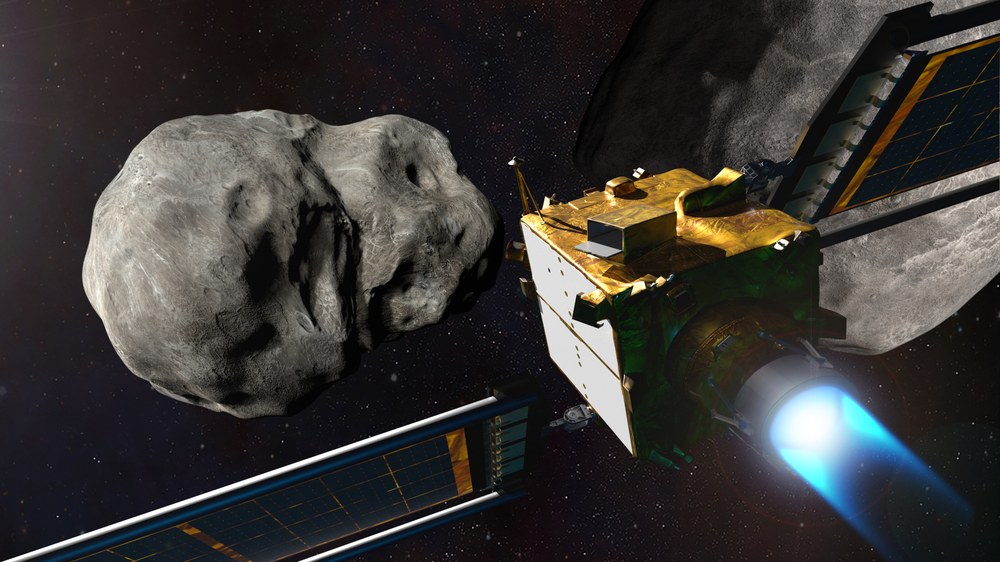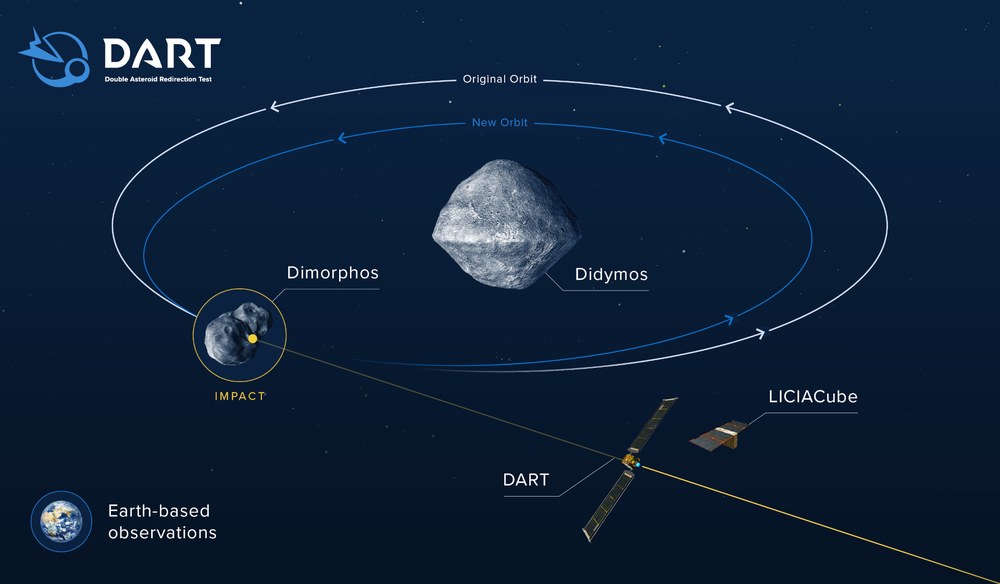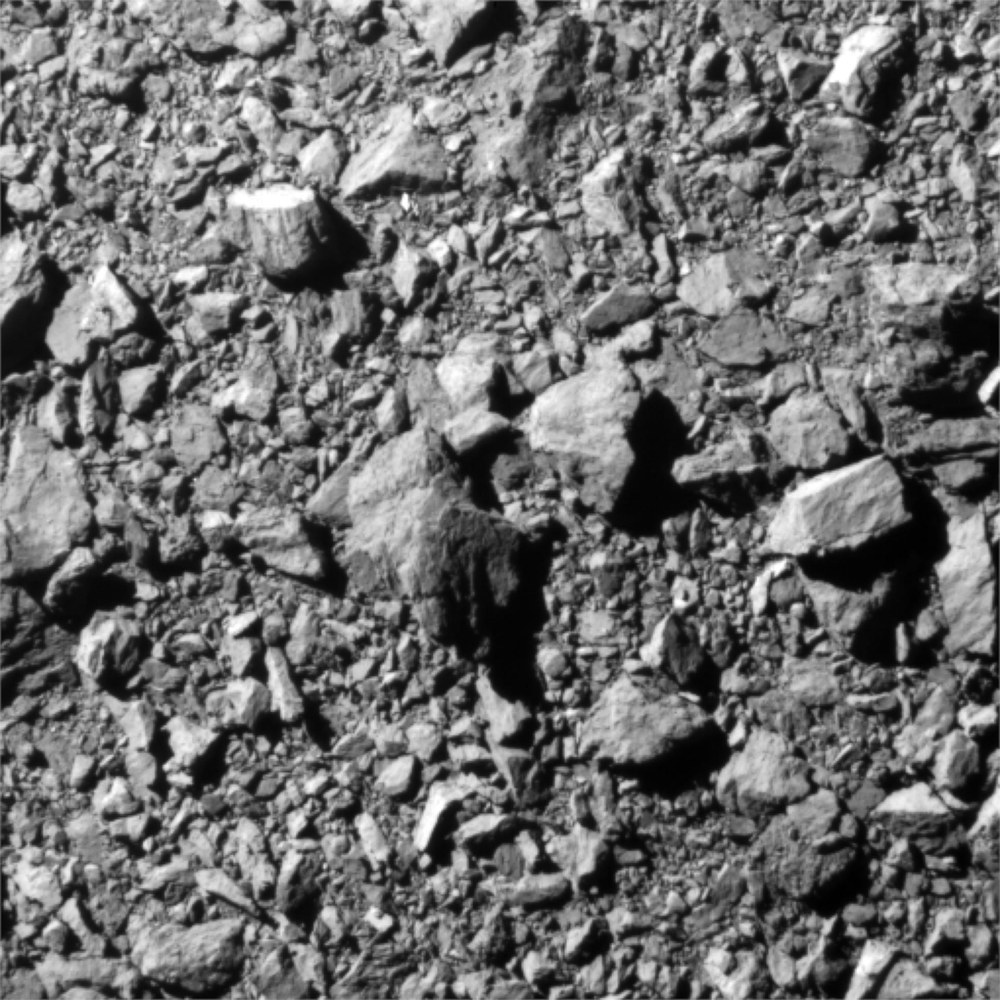Impact 11 million kilometres away



- NASA's DART spacecraft will reach the Didymos-Dimorphos binary asteroid system on 27 September 2022 at 01:14 CEST and impact the asteroid Dimorphos during a targeted approach.
- The spacecraft will crash on the 170-metre-diameter companion at almost 22,000 kilometres per hour, nudging it into a slightly tighter orbit around the 800-metre-diameter asteroid Didymos.
- It is the first time in the history of spaceflight that an attempt is made to change the orbit of a celestial body.
- Focus: Spaceflight, exploration, planetary defence, asteroids
+++ Update: NASA's DART spacecraft impacted the asteroid Dimorphos 11 million kilometres from Earthas planned at 01:14 CEST on 27 September 2022. This marks the first successful attempt to deflect a celestial body. Travelling at 22,000 kilometres per hour DART transmitted image and navigation data to the ground station at the Applied Physics Laboratory of Johns Hopkins University in Maryland (USA). "The navigation team did a fantastic job," says a delighted Jean-Baptiste Vincent of the German Aerospace Center (DLR). "DART seems to have hit Dimorphos right in the middle." The scientist from DLR's Institute of Planetary Research in Berlin is a member of the DART Science Team. He will now analyse the data from DART and the observations from the Italian small satellite LICIACube, which was launched by DART 15 days ago and flies behind it at a short distance, as well as many Earth-based telescope observations. "We are currently checking how much the orbital period around the larger Didymos has actually changed," says Stephan Ulamec from the DLR Microgravity User Support Center (MUSC) in Cologne. The model calculations assume one percent or a few minutes. "If that were the case, DART would be an important first step in protecting Earth from asteroid impacts." +++
In the early hours of Tuesday morning, NASA's Double Asteroid Redirection Test (DART) mission, which was launched in November last year, will test whether it is possible to change the course of an asteroid. DART will then reach the Didymos-Dimorphos asteroid binary system and impact the 170-metre wide 'moonlet' Dimorphos during a targeted approach. The 'kinetic momentum' transferred in the process is expected to alter the orbit of Dimorphos around its larger companion, Didymos. This is the first time in the history of spaceflight that an attempt is being made to influence the orbit of a celestial body by a human-made body. The German Aerospace Center (Deutsches Zentrum für Luft- und Raumfahrt; DLR) is involved in the analysis of the impact. In 2026, the ESA mission Hera, in which Germany is significantly involved through the German Space Agency at DLR, is to explore the asteroid system and its shifted orbit.
Earth has always been threatened by asteroid collisions. Although almost all of the approximately one million 'known' celestial bodies over 100 metres in size move in stable orbits between Mars and Jupiter, about 30,000 of these have orbits that intersect with Earth's orbit around the Sun. It is these bodies that could potentially collide with our planet. A collision of a body even a few hundred metres in size with Earth would cause quite considerable damage. Such danger may be averted by using space probes to alter the course of a potential Earth-colliding asteroid very early on so that it simply flies past our planet.
"We live in the age of space travel. This gives us the opportunity to use space probes to deflect an asteroid that may potentially collide with Earth," says Jean-Baptiste Vincent from the DLR Institute of Planetary Research. DLR has been observing and characterising Earth-crossing asteroids for decades. "On the one hand, we try to characterise these small, but sometimes dangerous, celestial bodies to understand their physical properties, and on the other hand we observe them to be able to draw conclusions on how we could ward them off should our calculations show that they could collide with Earth in the future," explains Stephan Ulamec from the DLR Microgravity User Support Center (MUSC) in Cologne.
Change in orbital period by a few minutes
The two DLR scientists are involved in NASA's DART mission. DART is a cube-shaped satellite with an edge length of just under two metres and a mass of 610 kilograms. The mission was launched on 24 November 2021 and steered on an elliptical orbit to its target, the asteroid pair Didymos and Dimorphos. Didymos, the larger of the two bodies, has an irregular diameter of nearly 800 metres, Dimorphos of about 170 metres. Dimorphos orbits Didymos – Greek for twin – in 12 hours at a distance of 1200 metres. Together, the two asteroids orbit the Sun in 25 months on an orbit that crosses Earth's orbit, making them potentially dangerous Near-Earth Objects (NEOs). In 2003, the two asteroids came within six million kilometres of Earth.
"We assume that Dimorphos' orbital period around Didymos will change by a few minutes due to DART's momentum," predicts DLR researcher Stephan Ulamec. "However, we do not know what Dimorphos is like," adds Jean-Baptiste Vincent. "Is it a compact body or are its components only very loosely assembled? In other words, is Dimorphos maybe just a pile of rock fragments, a 'rubble pile' as we say in asteroid research?" The task of the two DLR scientists in the DART team is to determine the exact shape of the small asteroid, its precise mass and to analyse the crater and the transmission of the momentum and ejecta produced by the impact.
The spacecraft will, of course, be completely destroyed in the process, but the impact of DART on Dimorphos will be observed by two small cubesats which were deployed on 11 September. The two LICIACubes were developed by the Italian Space Agency (ASI) to make flyby observations of the Didymos binary asteroid system following DART’s impact. The small satellites will communicate directly with Earth before, during and after the impact. Two cameras (LUKE and LEIA) will confirm the impact and capture images of the ejecta cloud and possibly a crater. Three minutes after DART's impact, they will have flown past Dimorphos, turning and still taking pictures of the far side of Dimorphos, which of course DART will not get to see up close. LICIACube is the first all-Italian autonomous space probe in space. NASA's Lucy mission, launched last year to the 'Trojan' asteroids in Jupiter's orbit, will also observe the impact from a distance of 19 million kilometres.
Will we be able to deflect asteroids in the future?
The targeted collision of the DART spacecraft with Dimorphos will occur on 27 September 2022 at 01:14 CEST at a distance of just over 11 million kilometres from Earth, the closest the binary asteroid system will be to Earth in the near future (the asteroid pair will not pass Earth at a similarly close distance again until 2062). Being this 'close' to Earth also provides good observing opportunities for telescopes on the planet's night side, especially from Europe; observations that will be used for complementary analyses during and after the collision. These and other telescopes will also record light curves of the binary asteroid system in the nights after the event to contribute data on Dimorphos’ orbital alteration to the overall analysis.
Nearly 11 million kilojoules of energy are converted during DART's impact with Dimorphos. The researchers assume that the impact will create a crater several tens of metres in diameter and that the asteroid’s orbital period will change measurably, by a few minutes. This corresponds roughly to a change in velocity of half a millimetre per second. "How efficiently an asteroid is deflected by colliding with a space probe is decisively influenced by the physical properties of the body, in other words, it depends on how porous and solid the rock is," explains Kai Wünnemann from the Museum für Naturkunde Berlin, whose team has been developing computer simulations of the impact process in order to make predictions that are as precise as possible. At the Museum für Naturkunde Berlin, various scenarios of the nature of Dimorphos are run and simulated in order to predict the size of the crater, among other things.
In October 2024, the European Space Agency (ESA) will launch Hera, a mission coordinated with NASA, which will be developed and built largely in Germany, to study the impact and its consequences in detail. The German Space Agency at DLR, based in Bonn, manages the German ESA contributions for Hera. Hera will reach the binary asteroid system in December 2026, approximately four years after the impact of DART. Hera's detailed investigations will then significantly expand knowledge about the possibilities afforded by asteroid deflection. DART and Hera are missions of the international research project AIDA (Asteroid Impact and Deflection Assessment).
Repeated asteroid impacts in Earth's history
In the foreseeable future, there is currently no reason to worry about an asteroid hitting Earth. But asteroid collisions have happened again and again in Earth's four-and-a-half billion years of history. Traces of these can be found in the craters left behind when asteroids hit, such as the Nördlinger Ries in southern Germany or the Barringer Crater in Arizona. The Moon, littered with impact craters, makes it clear that asteroid collisions used to be much more frequent. However, on the dynamically ever-changing Earth, almost all traces of impacts have been erased. The extinction of the dinosaurs was caused by an asteroid collision 65 million years ago. That the danger of an asteroid hitting Earth remains real today, albeit on a much smaller scale, became clear on 15 February 2013. At that time, an unknown asteroid entered Earth's atmosphere and exploded over the Russian city of Chelyabinsk. The shockwave of compressed air from Earth's atmosphere caused considerable damage in the city. Thousands of window panes were shattered, injuring more than 1600 people. The total damage was estimated at 30 million euros. Yet the asteroid in Chelyabinsk was only about 18 metres in diameter.
